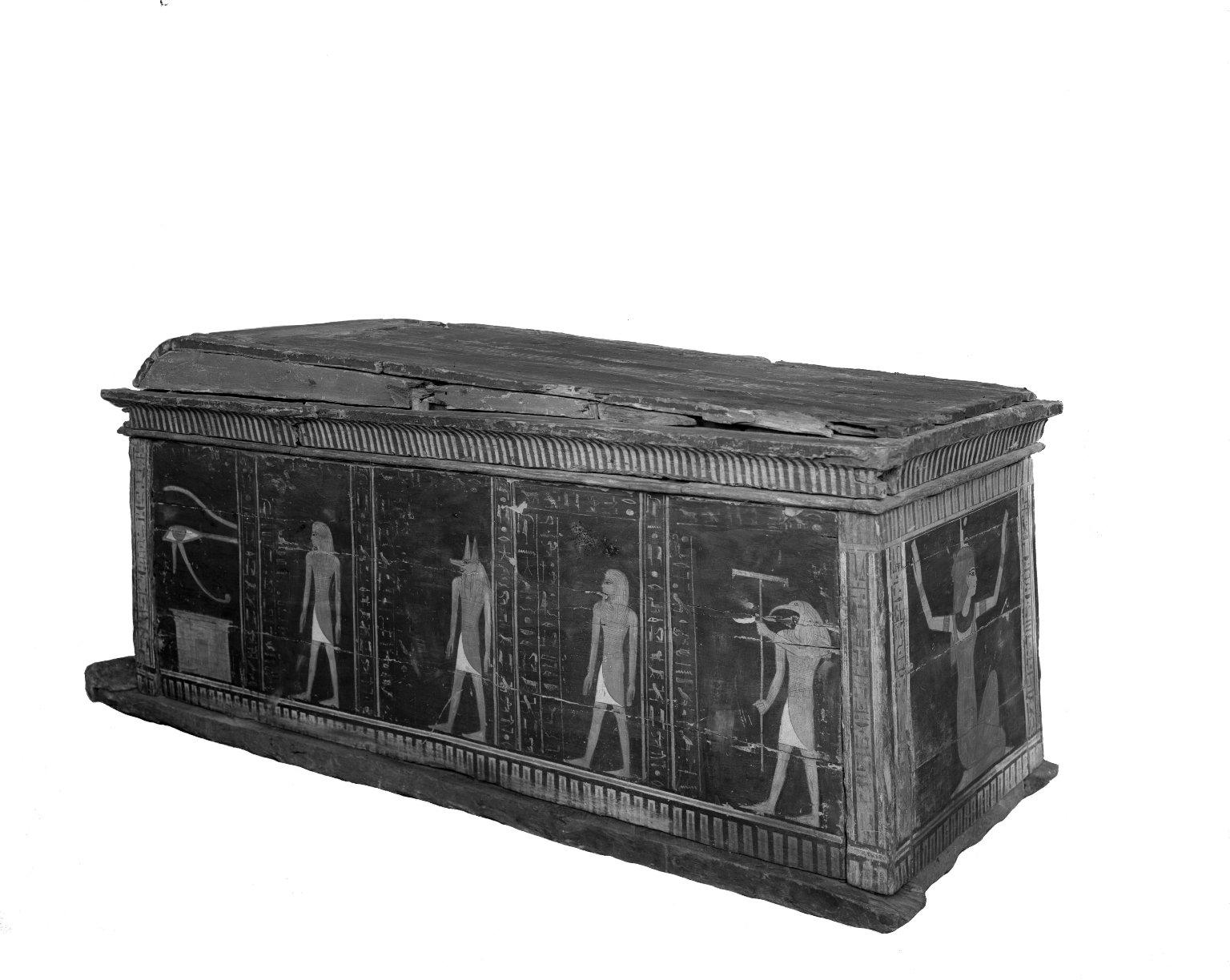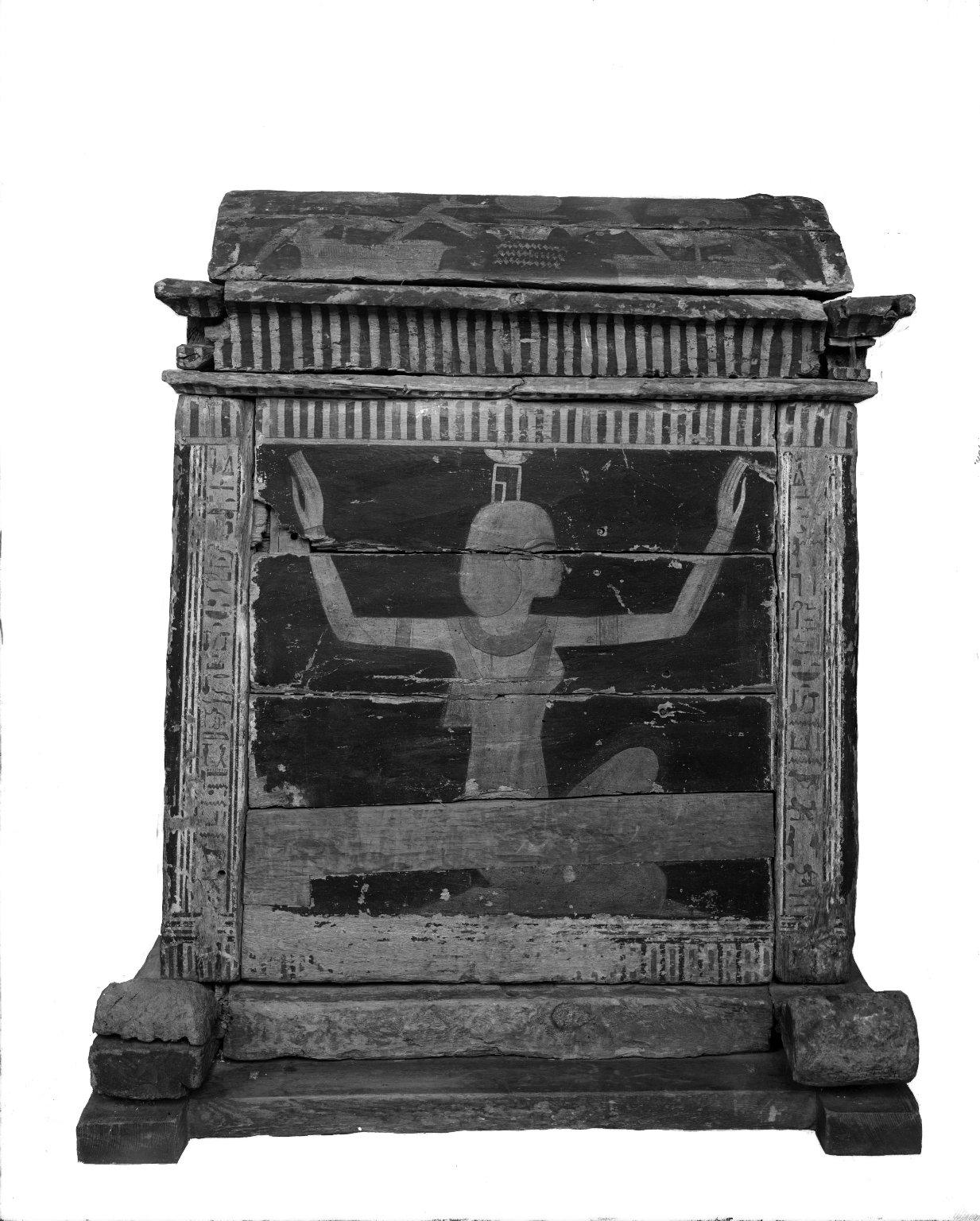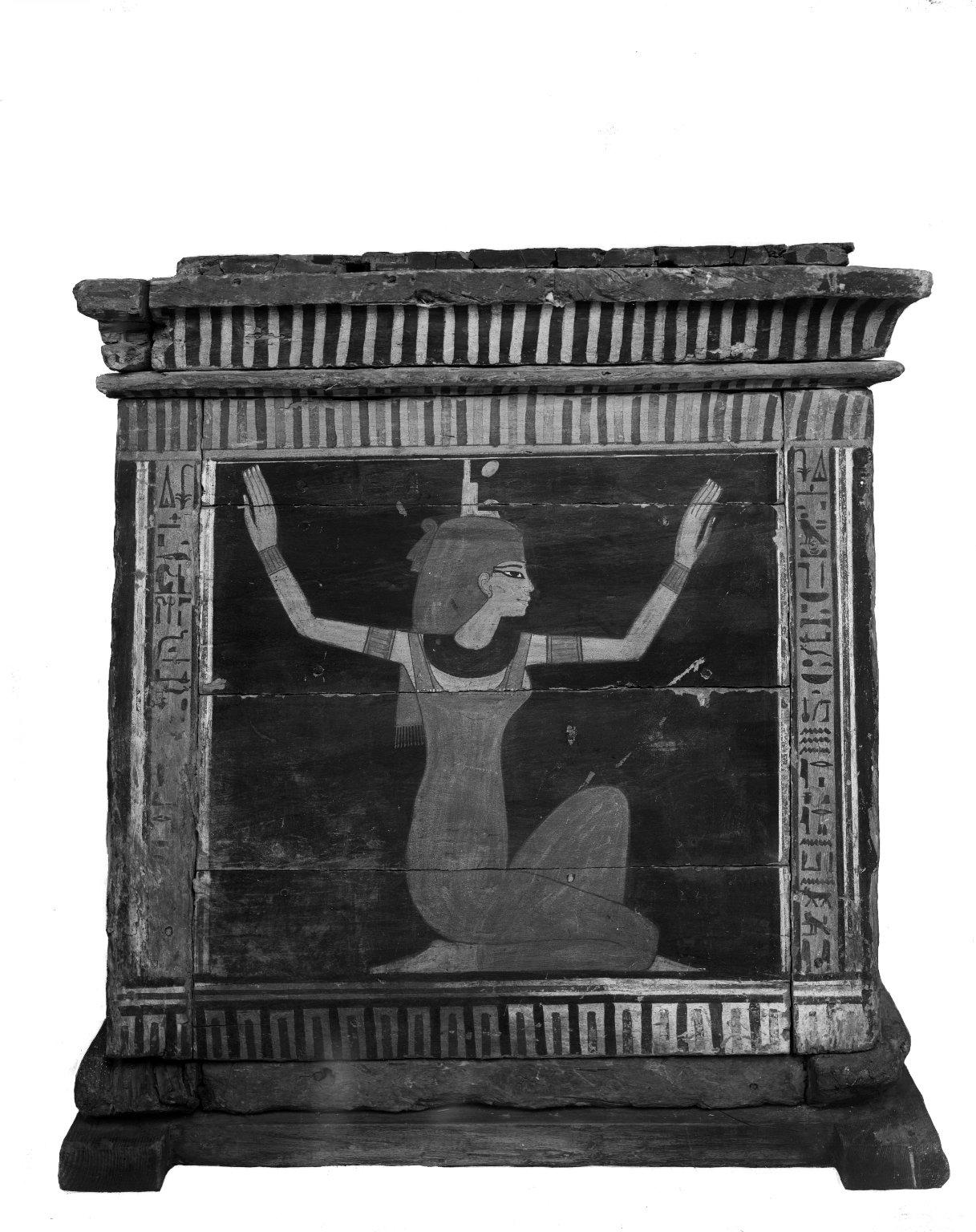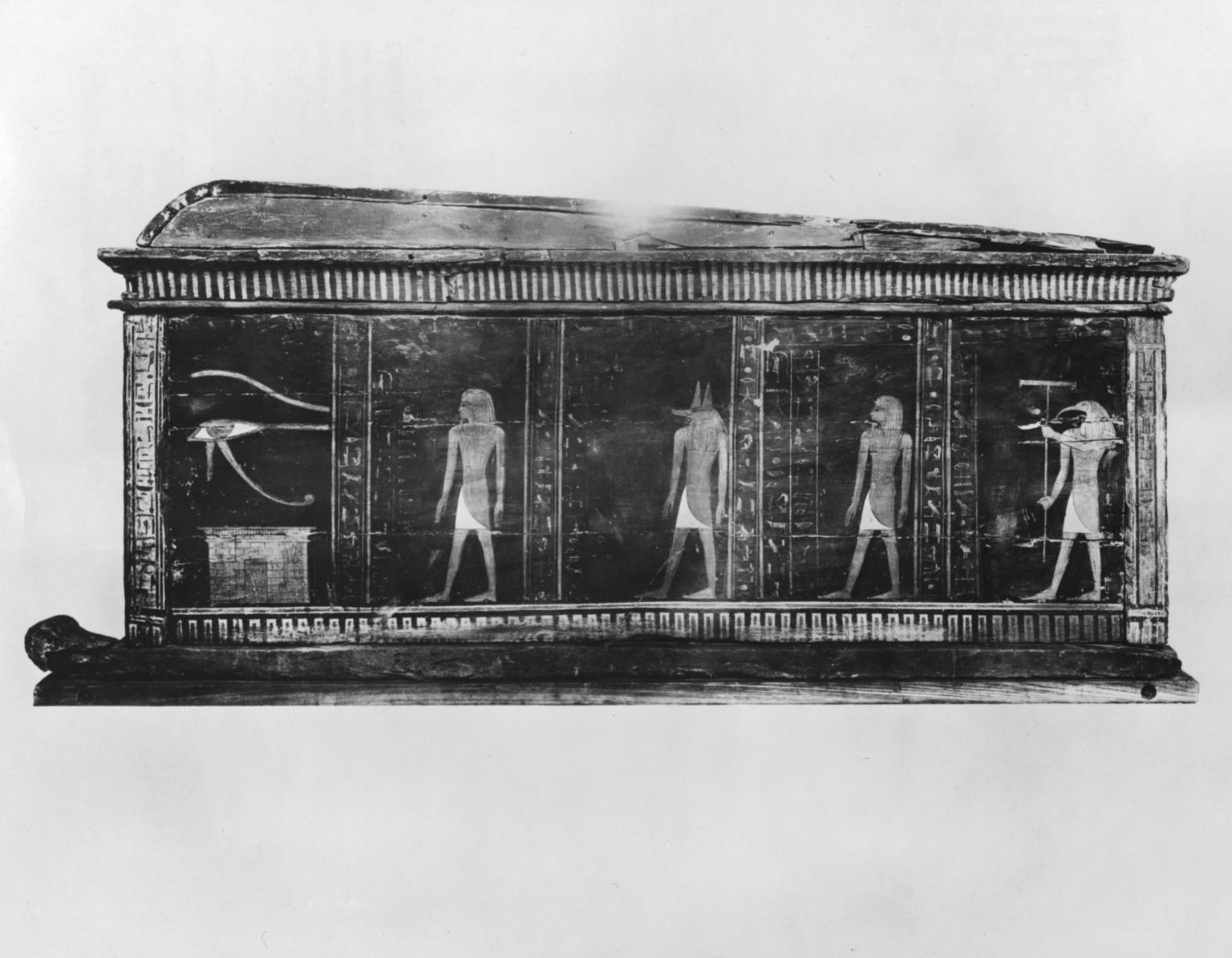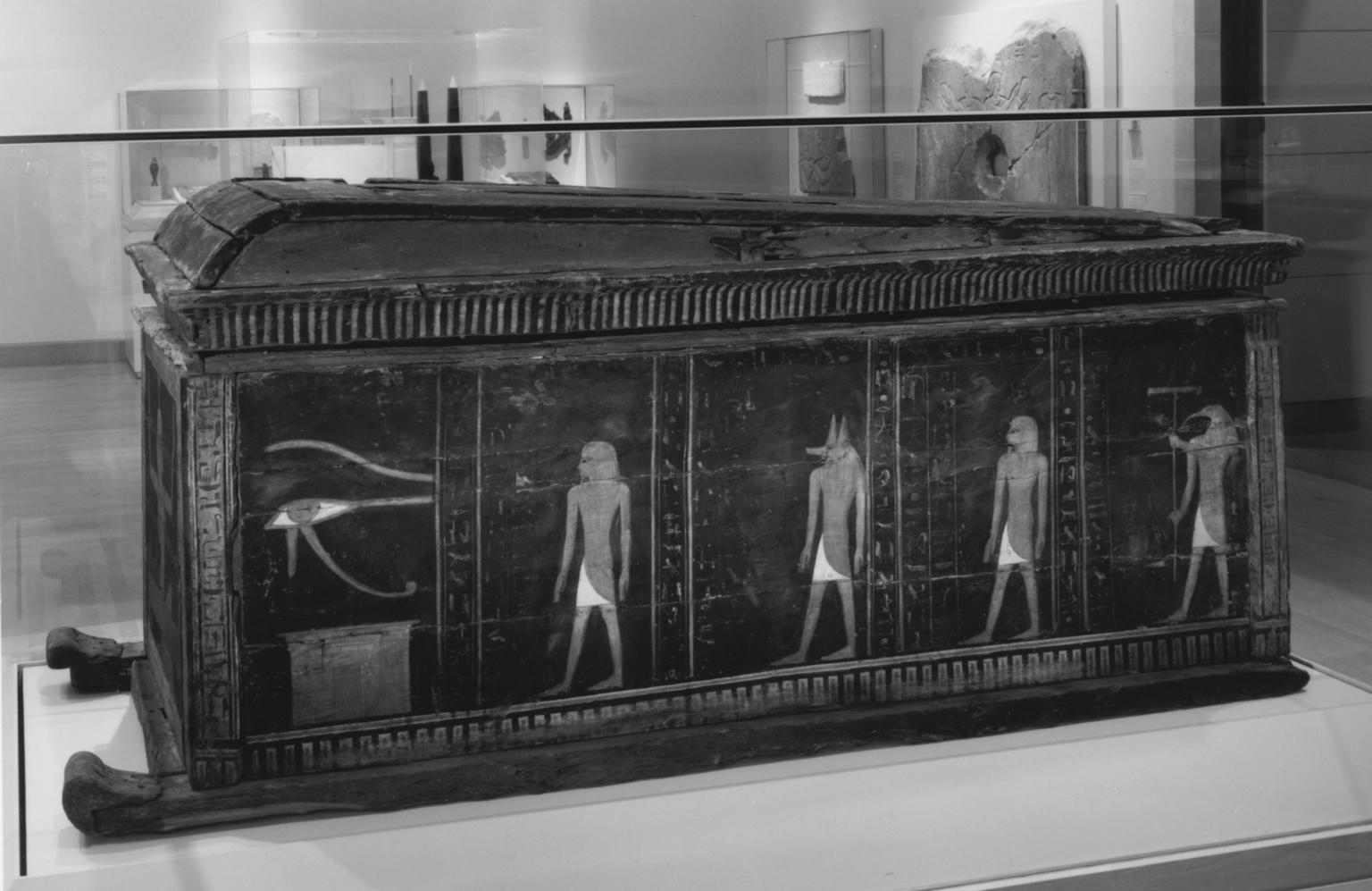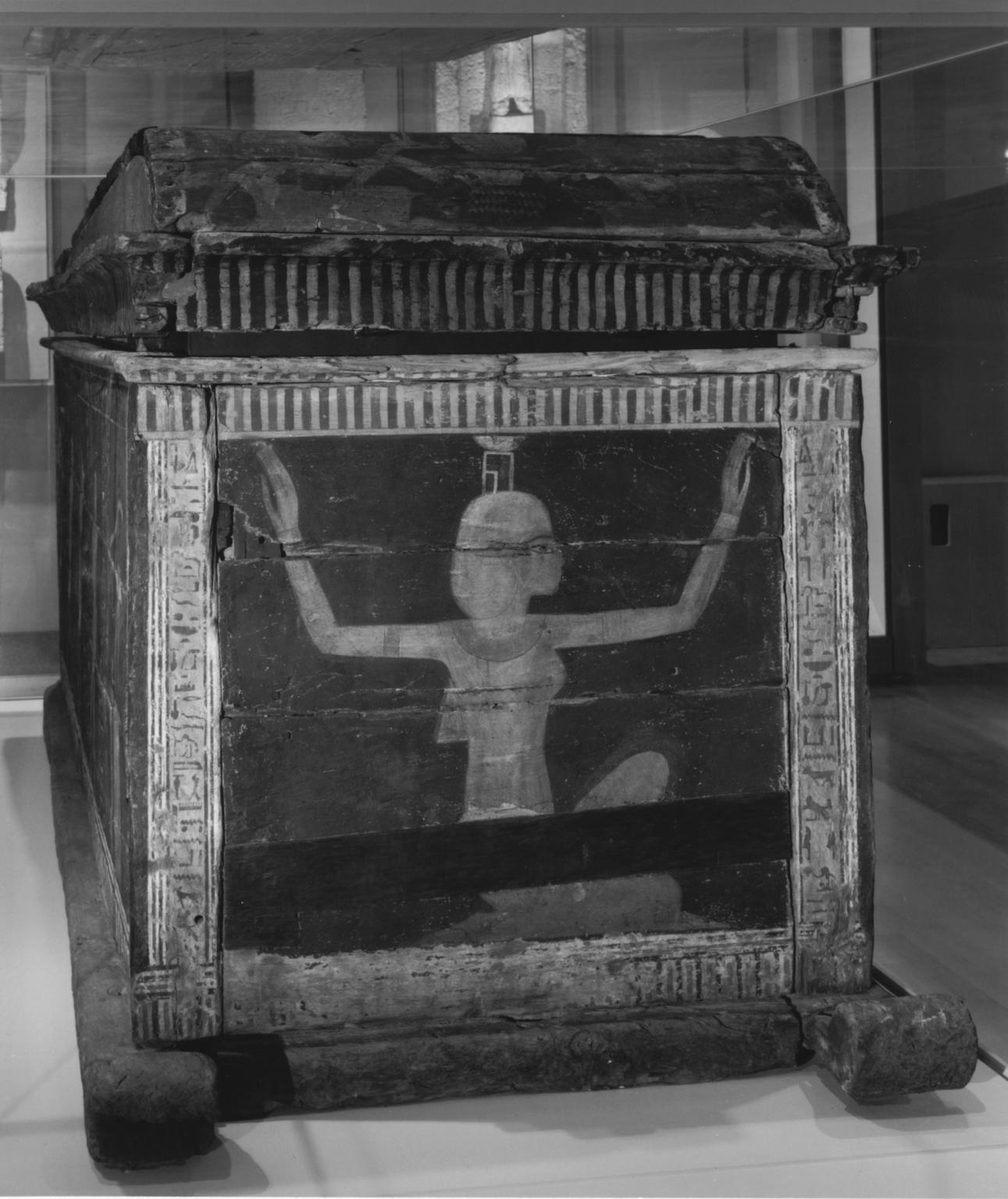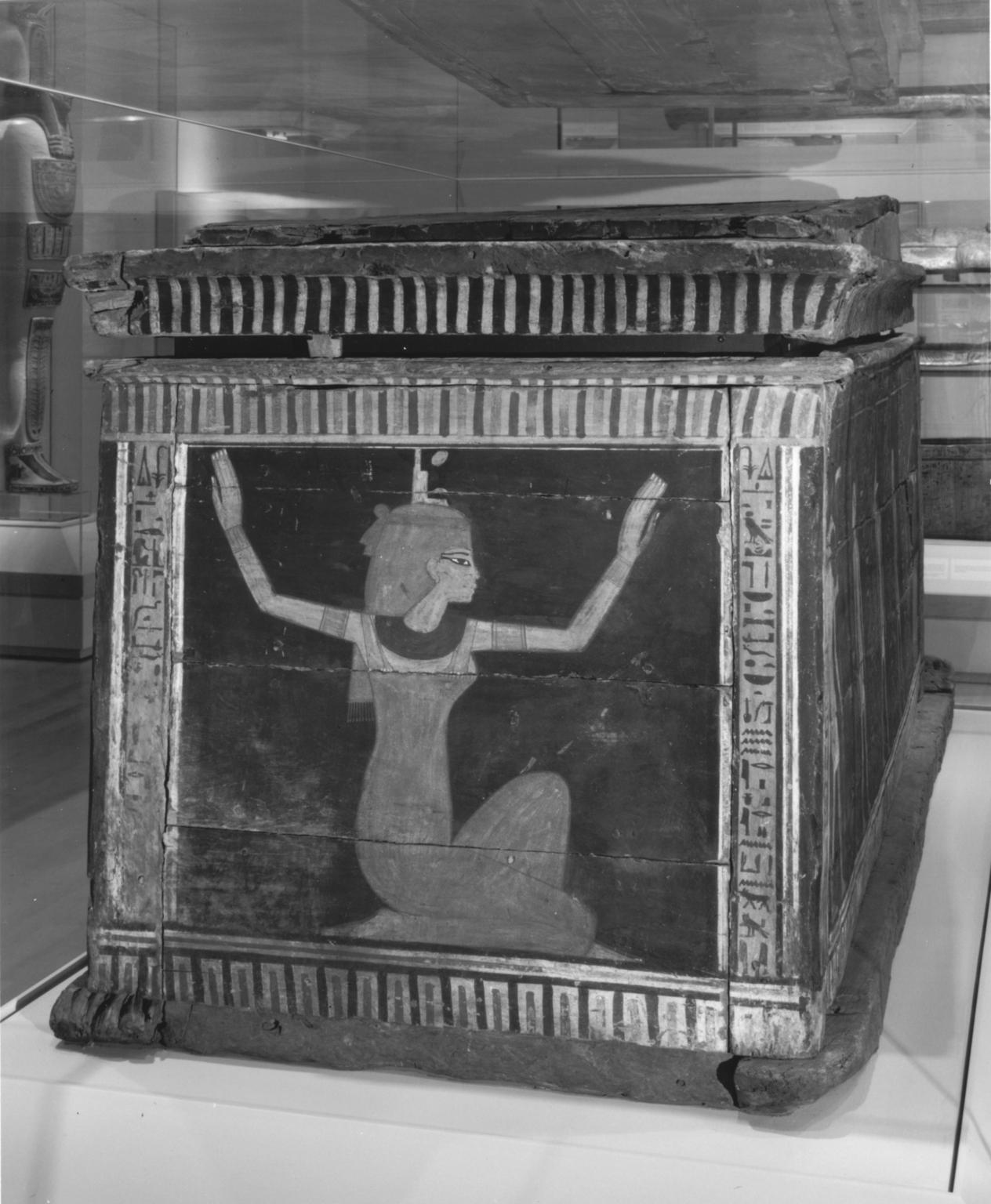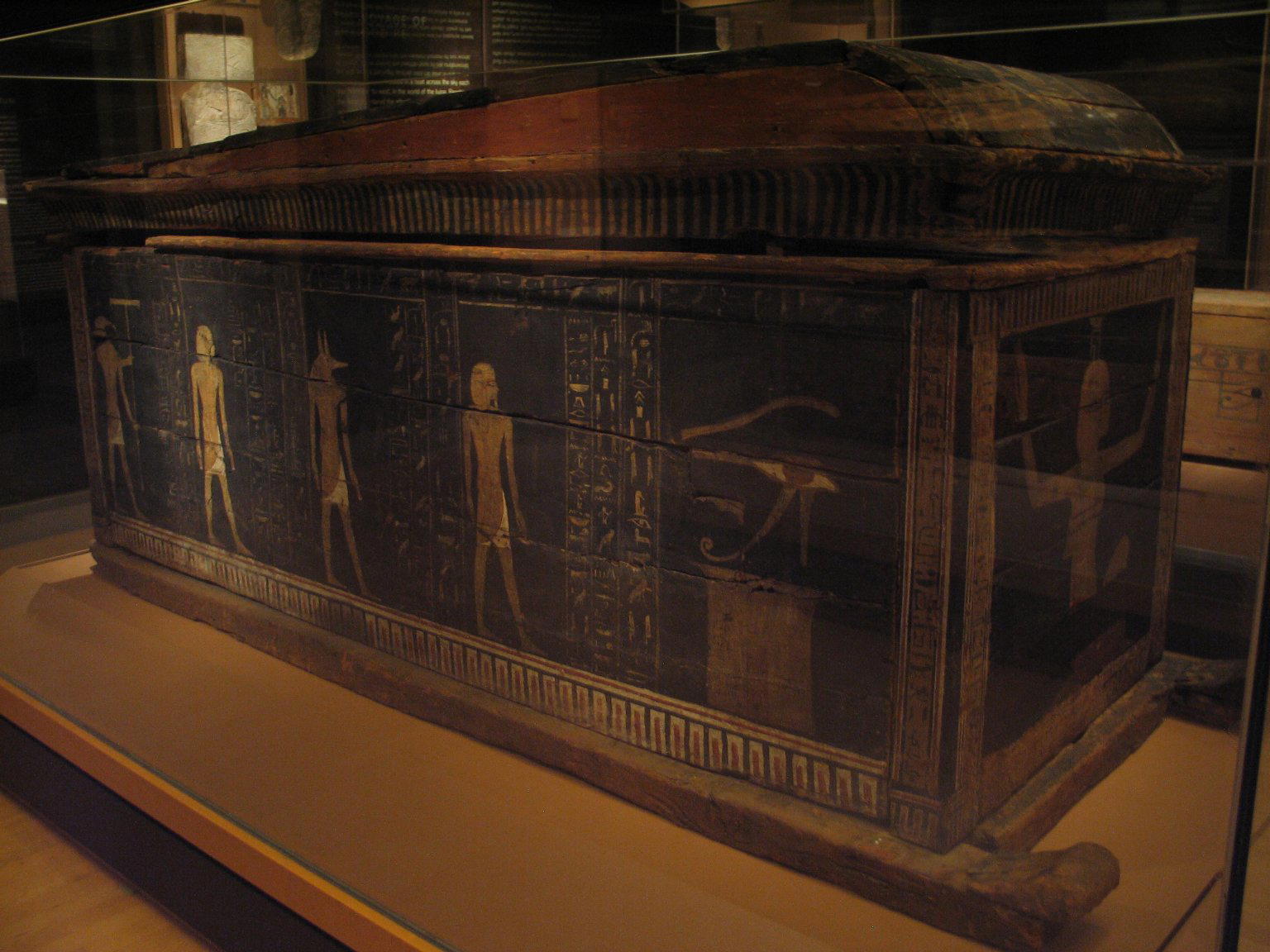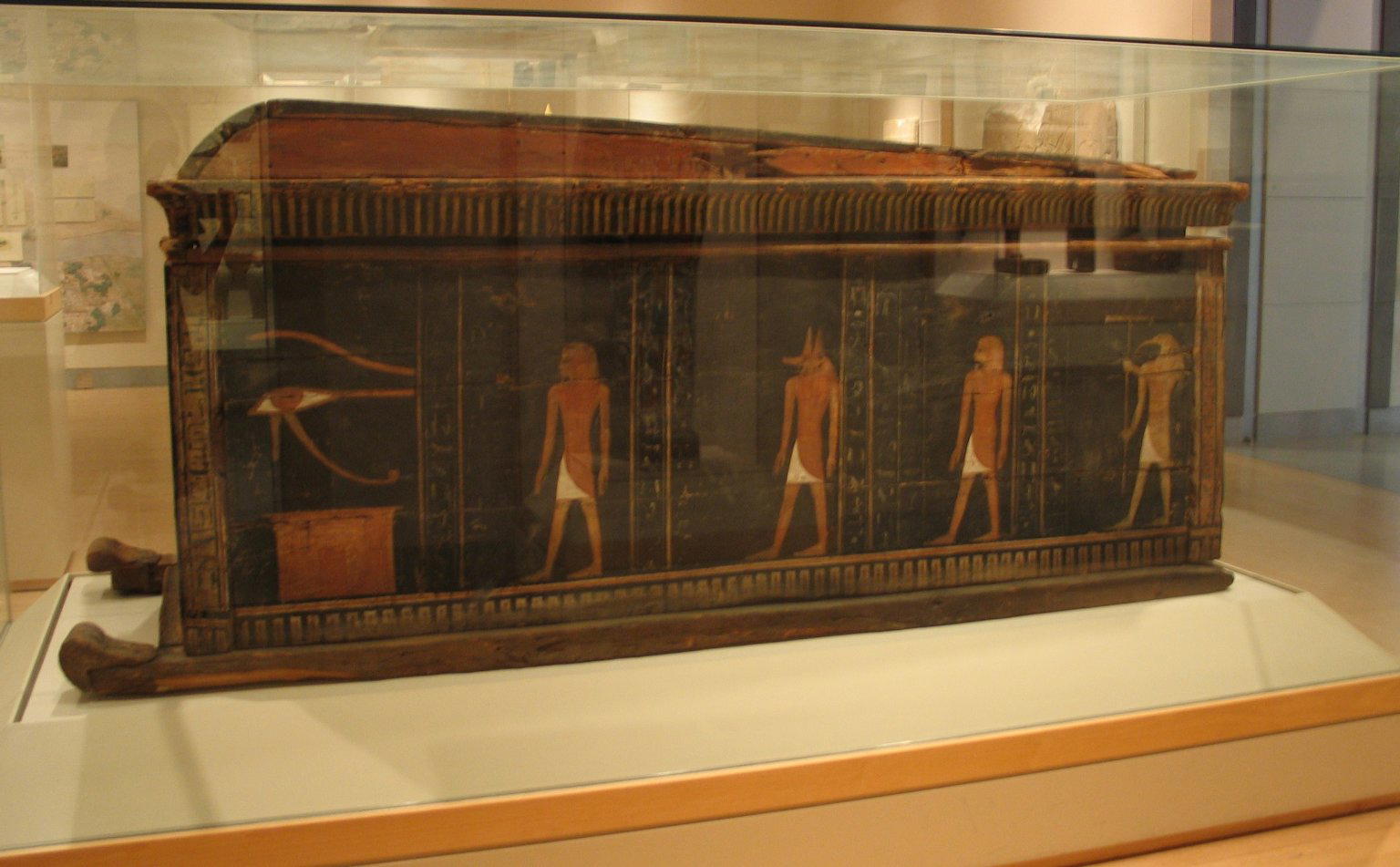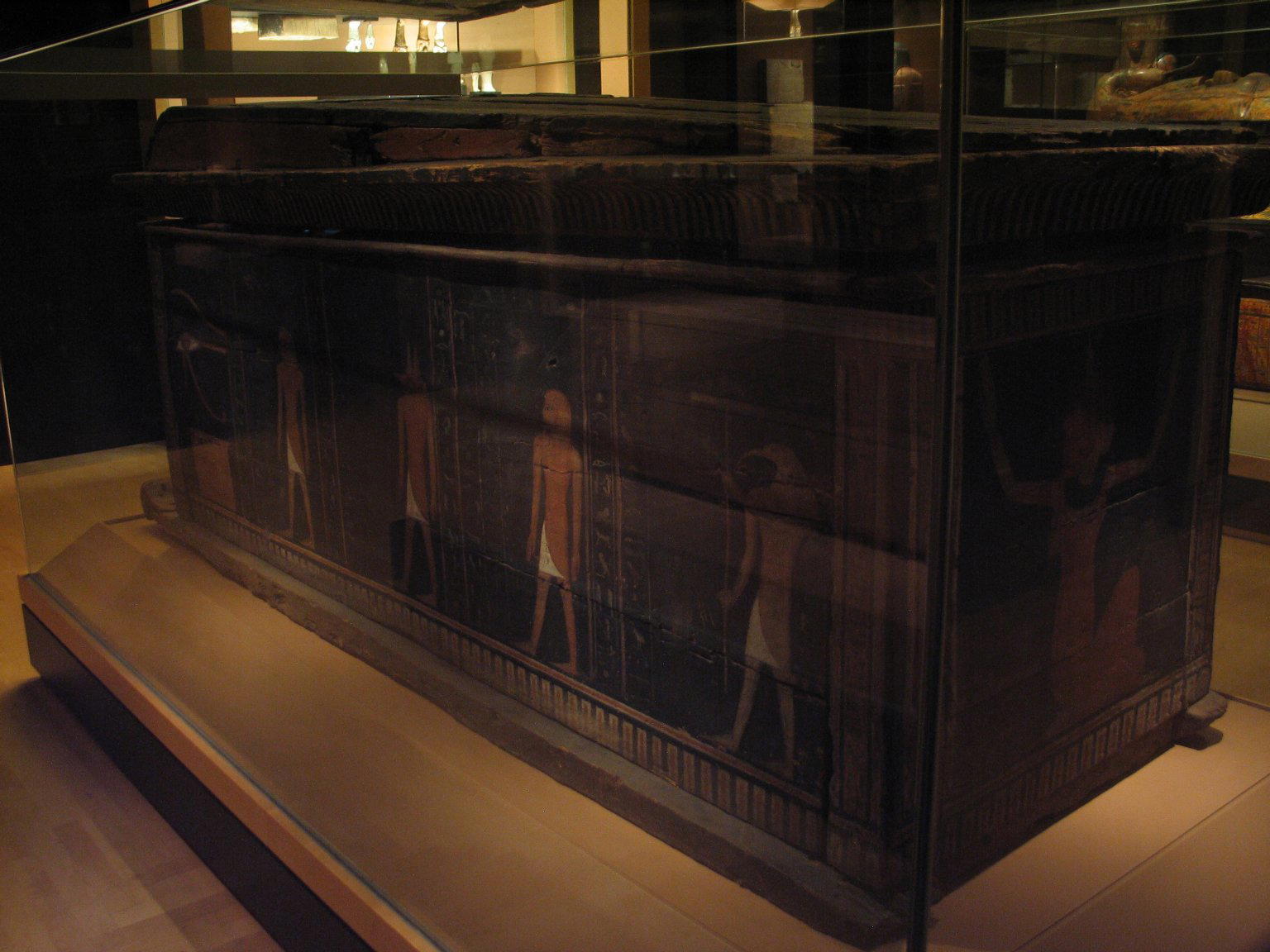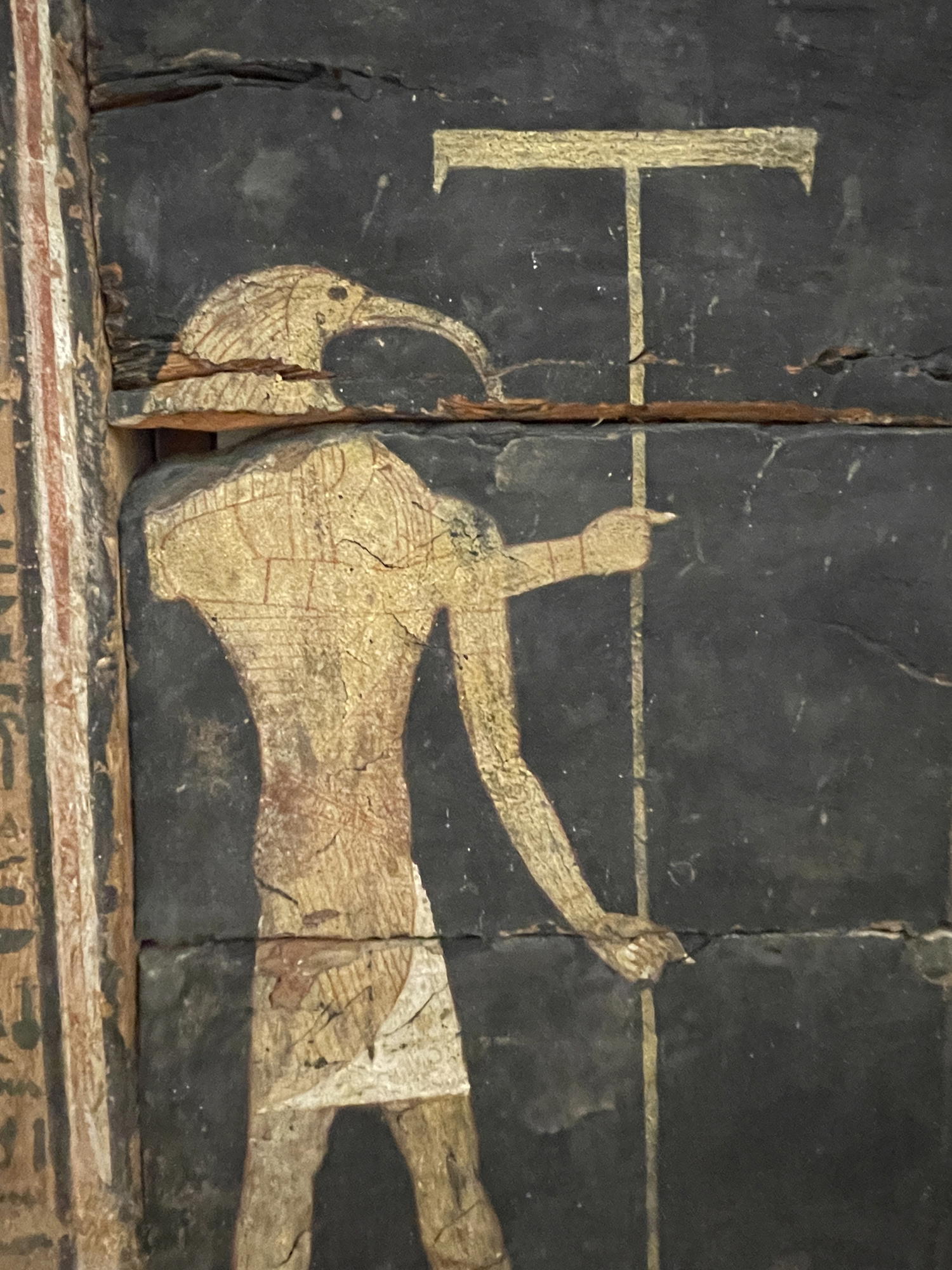Outer Coffin of Kamwese
ca. 1390–1352 B.C.E.
1 of 79
Object Label
This coffin type developed from the rectangular type used for Princess Mayet, shown nearby. Kamwese’s is shaped like a shrine, but with runners along the bottom (perhaps used to transport the coffin from the embalming hall to the tomb). A human-shaped coffin was originally placed inside it. The images on each long side include a wadjet-eye, symbolizing completeness, positioned above a shrine and guardian deities and spells. The mourning goddesses Isis and Nephthys, on each short end, help associate the deceased with Osiris.
Caption
Outer Coffin of Kamwese, ca. 1390–1352 B.C.E.. Wood, pigment, 41 3/4 x 35 7/16 x 95 1/4 in. (106 x 90 x 242 cm). Brooklyn Museum, Charles Edwin Wilbour Fund, 37.15E. (Photo: Brooklyn Museum)
Title
Outer Coffin of Kamwese
Date
ca. 1390–1352 B.C.E.
Dynasty
Dynasty 18
Period
New Kingdom
Geography
Possible place made: Thebes (Deir el-Medina), Egypt, Reportedly from: Thebes (vicinity), Egypt
Medium
Wood, pigment
Classification
Dimensions
41 3/4 x 35 7/16 x 95 1/4 in. (106 x 90 x 242 cm)
Credit Line
Charles Edwin Wilbour Fund
Accession Number
37.15E
Frequent Art Questions
What kind of wood was used to make the outer coffin of Kamwese?
 We aren't sure, most wooden coffins were made from Sycamore or Acacia. Wood was fairly rare and expensive in Egypt. Due to the climate, and the amount of water that timber trees require; most wood would need to be imported. It may seem like most things in Ancient Egypt were made of stone, but this is largely untrue, furniture and baskets and many other things made from wood and plants simply didn't survive as well as things made from stone.
We aren't sure, most wooden coffins were made from Sycamore or Acacia. Wood was fairly rare and expensive in Egypt. Due to the climate, and the amount of water that timber trees require; most wood would need to be imported. It may seem like most things in Ancient Egypt were made of stone, but this is largely untrue, furniture and baskets and many other things made from wood and plants simply didn't survive as well as things made from stone.Why is the Eye of Horus painted on the side of coffins?
 The Eye of Horus or wedjat-eye was a symbol of health, rejuvenation, and prosperity to the Ancient Egyptians. These concepts were also very important to the deceased on their journey to the afterlife which is why you see some many of them on funerary objects like sarcophagi.
The Eye of Horus or wedjat-eye was a symbol of health, rejuvenation, and prosperity to the Ancient Egyptians. These concepts were also very important to the deceased on their journey to the afterlife which is why you see some many of them on funerary objects like sarcophagi.What is this?
 That's a painting of the goddess Isis. Her pose indicates that she is protecting something, in this case the mummy of a man named Kamwese.
That's a painting of the goddess Isis. Her pose indicates that she is protecting something, in this case the mummy of a man named Kamwese.Is there anything you can tell me about this?
 Of course! This coffin belonged to Kamwese, who lived in Ancient Egypt over two thousand years ago! It was made of wood, which would have been a rather expensive material at the time, as it would have had to be imported.The symbols on the coffin are associated with protection and meant to help the deceased's transition into the afterlife. The word for coffin in Ancient Egypt was the same word as "egg," so it really was an object to help in the birth into the afterlife. If you can spot the eye on the side, that's a very cool symbol and one you might see while walking around the rest of the galleries. It's called a "wedjat-eye" and is a symbol for health and prosperity.
Of course! This coffin belonged to Kamwese, who lived in Ancient Egypt over two thousand years ago! It was made of wood, which would have been a rather expensive material at the time, as it would have had to be imported.The symbols on the coffin are associated with protection and meant to help the deceased's transition into the afterlife. The word for coffin in Ancient Egypt was the same word as "egg," so it really was an object to help in the birth into the afterlife. If you can spot the eye on the side, that's a very cool symbol and one you might see while walking around the rest of the galleries. It's called a "wedjat-eye" and is a symbol for health and prosperity. This?Yes! That's it.
This?Yes! That's it.Who was Kamwese?
So it looks like the coffin doesn't say who Kamwese was, so we unfortunately don't know. It is likely that he lived in Thebes. Based on comparison to other coffins and inscriptions, he probably did not have an important title or work government like many of our mummies did, but he clearly had enough money to commission a beautiful coffin!Could the eye on this sarcophagus be a representation of time (the omnipotent entity that defies mortality)?
 That is called a Wedjat and is the eye of Horus. In Egyptian mythology, the eye of Horus was magically restored following damage inflicted by his uncle Seth. It symbolized health, rejuvenation, and prosperity.However, in this context, on a sarcophagus, the eye can be interpreted as allowing the deceased to see out or even keeping watch.
That is called a Wedjat and is the eye of Horus. In Egyptian mythology, the eye of Horus was magically restored following damage inflicted by his uncle Seth. It symbolized health, rejuvenation, and prosperity.However, in this context, on a sarcophagus, the eye can be interpreted as allowing the deceased to see out or even keeping watch.Tell me more.
 This wooden coffin is in the shape of a shrine. Kamwese likely saved up for a long time to afford this coffin. Based on the inscriptions, it does not appear that he held any titles suggesting he had to work hard to make his money. His coffin is adorned with gods (the sons of Horus, Isis, and Nephthys) to mourn and protect him in death.
This wooden coffin is in the shape of a shrine. Kamwese likely saved up for a long time to afford this coffin. Based on the inscriptions, it does not appear that he held any titles suggesting he had to work hard to make his money. His coffin is adorned with gods (the sons of Horus, Isis, and Nephthys) to mourn and protect him in death.How did they make the coffins?
The Wooden Coffin of Kamwese in the Mummy Chamber was made out of wood.The wood itself would have been have been cut to size from local or imported trees, sanded to create a smooth surface for painting, and carved with any designs like the niched base of Kamwese's coffin.The entire coffin would then covered with a layer of gesso and paint made from mineral pigments was used to further decorate the outside with hieroglyphic inscriptions and depictions of the deceased, and various gods.Why does he have an animal head and a human body?
 This jackal-headed man represents the god Anubis. The ancient Egyptians, very often, depicted their gods as humans with the heads of the animals they were associated with.Anubis was the god of mummification and cemeteries and also aided on the journey to the afterlife. He was associated with jackals or desert dogs like those that live at the edge of the desert where the Egyptians bury their dead.
This jackal-headed man represents the god Anubis. The ancient Egyptians, very often, depicted their gods as humans with the heads of the animals they were associated with.Anubis was the god of mummification and cemeteries and also aided on the journey to the afterlife. He was associated with jackals or desert dogs like those that live at the edge of the desert where the Egyptians bury their dead.What is she doing?
 This image represents the goddess Nephthys and she is mourning. Nephthys and her sister, Isis, who is depicted on the opposite end of this coffin, are considered the archetypal mourners. They were popular decoration for coffins because they ancient Egyptians wanted the sisters to mourn over themselves the way they mourned over the god Osiris.
This image represents the goddess Nephthys and she is mourning. Nephthys and her sister, Isis, who is depicted on the opposite end of this coffin, are considered the archetypal mourners. They were popular decoration for coffins because they ancient Egyptians wanted the sisters to mourn over themselves the way they mourned over the god Osiris.Dime más.
 Esta ataúd pertence a un hombre llamado Kamwese. No tenía un rango muy alto, por lo que probablemente tuvo que ahorrar dinero durante mucho tiempo para pagar este ataúd. La decoracion y la inscripcion habria ayudado al fallecido en su viaje al la vida después de la muerte.Puedes ver en el lado largo Imesty, Anubis, Duamutef, y Thoth.Anubis, con la cabeza de un perro, y Thoth, con la cabeza de un ibis, fueron particularmente importantes.
Esta ataúd pertence a un hombre llamado Kamwese. No tenía un rango muy alto, por lo que probablemente tuvo que ahorrar dinero durante mucho tiempo para pagar este ataúd. La decoracion y la inscripcion habria ayudado al fallecido en su viaje al la vida después de la muerte.Puedes ver en el lado largo Imesty, Anubis, Duamutef, y Thoth.Anubis, con la cabeza de un perro, y Thoth, con la cabeza de un ibis, fueron particularmente importantes.Could you please explain who these people are?
 These are four Egyptian deities! Going from left to right, first you have Thoth, who is depicted as a man with the head of an ibis.He is the god of wisdom, also associated with knowledge and writing! The curved, slender beak of the ibis resembles the scribes writing implement.Next is Qebehsenuef, one of the four sons of Horus, he is the god of protection and of the West!Next is Anubis, the jackal headed god. He was a protector of the dead associated with mummification, cemeteries and the journey to the afterlife.Lastly is Hapy, another of the four sons of Horus, and the god of the inundation, or annual Nile flood.
These are four Egyptian deities! Going from left to right, first you have Thoth, who is depicted as a man with the head of an ibis.He is the god of wisdom, also associated with knowledge and writing! The curved, slender beak of the ibis resembles the scribes writing implement.Next is Qebehsenuef, one of the four sons of Horus, he is the god of protection and of the West!Next is Anubis, the jackal headed god. He was a protector of the dead associated with mummification, cemeteries and the journey to the afterlife.Lastly is Hapy, another of the four sons of Horus, and the god of the inundation, or annual Nile flood.My 7yr old wants to know why he has the face of an animal.
 That's because he is an Egyptian god! Egyptian gods are often shown with animal heads. This one is Anubis, god of the mummification and protector of cemeteries! His animal is the jackal or desert dog because the ancient Egyptians buried their dead at the edge of the desert where the jackals lived.
That's because he is an Egyptian god! Egyptian gods are often shown with animal heads. This one is Anubis, god of the mummification and protector of cemeteries! His animal is the jackal or desert dog because the ancient Egyptians buried their dead at the edge of the desert where the jackals lived.
Have information?
Have information about an artwork? Contact us at
